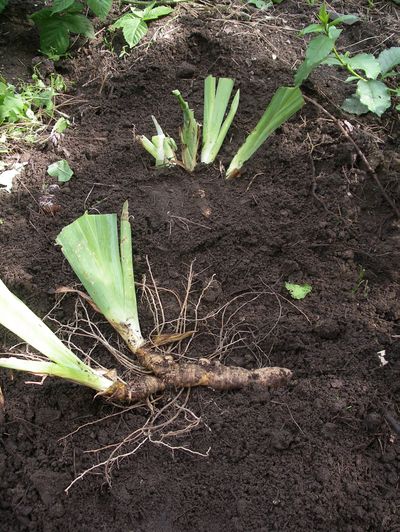Dramatic irises slowly multiply

I always look forward to the bearded iris when they start blooming in early June. Their bold flowers and leaves add a great dramatic element to the garden.
The versatility and beauty of the iris have made them popular for centuries. They were an important part of classic Greek culture and mythology. The classic French fleur-de-lis is thought to be a stylized iris. Iris roots were easy to carry from place to place and traveled far and wide with settlers in a number of cultures.
Bearded irises are the most popular and widely planted variety. The term “beard” refers to hairs that stand up on the top of the three drooping petallike sepals or “falls” that hang from the base of the flower. The bearded iris come in a surprising range of sizes from 3- to 4-foot-tall plants down to 6- to 8-inch dwarfs. The taller varieties are perfect for the back of borders, while the smaller varieties add spiky interest to the middle and front of plantings.
Bearded iris and their close cousins the beardless iris all grow from a fleshy root called a rhizome. The rhizome grows right at the surface of the ground and actually projects a little above it. The straplike leaves grow from one end of the rhizome. Each year the plant grows a new root and the clump slowly expands and can become quite large. They will grow in a wide range of soil conditions and fertility levels. Once established, they are fairly drought tolerant which makes them perfect for the back of a border where the sprinkler might not reach completely. They are very hardy and deer and pest resistant.
Irises need about two months of rest after blooming before they can be divided in late July through late August. This allows them time to store up reserves for next year. Clumps usually need dividing every four or five years to keep them blooming profusely.
To divide a clump, work it out of the ground with a spading fork or shovel, being careful not to break too many of the large rhizomes. Divide it keeping the largest whiter roots from the outside of the clump. Cut the foliage back by two-thirds.
The biggest mistake gardeners make when planting iris is planting them too deep. Dig a hole 6 inches deep and twice as wide as the rhizome is long. Mound up a hill of soil in the middle of the hole and set the rhizome on it so that the top is at or slightly above the soil surface. Spread the smaller roots out and down a little in the hole before filling the dirt into the whole. The top of the rhizome should be at the soil surface.
Irises are usually available in the garden centers and catalogs by early August. Look for firm, white roots with no nicks or dings. They should not look dried out. There should be a healthy set of smaller roots coming off the main rhizome.